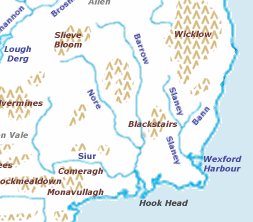River Nore


The River Nore is a 87-mile-long river that flows from County Tipperary to the Celtic Sea at Waterford. Along with the River Suir and River Barrow, it is one of the constituent rivers of the group known as the Three Sisters. The river drains approximately 977 square miles of Leinster.[1][2] The long term average flow rate of the River Nore is 56 cubic yards per second[2] The river rises in the Devil's Bit Mountain, County Tipperary. Flowing generally southeast, and then south, before emptying into the Celtic Sea at Waterford Harbour, Waterford.
Parts of the river are listed as Special Areas of Conservation.[3]
Name
The river is known in the Irish language as An Fheoir, possibly referring to féar, "grass." In 1732 John Loveday spelled it Neor and Neure.[4]
Course
The Nore rises on the eastern slopes of the Devil's Bit Mountain in the townland of Borrisnoe, County Tipperary. It then flows south-eastwards to County Laois and County Kilkenny before joining the River Barrow just north of New Ross near the Barrow Bridge.[5] The river passes near Durrow, County Laois then through Ballyragget, the city of Kilkenny and then the villages of Bennettsbridge and Thomastown. It flows through the Mount Juliet estate. Further south, it forms a picturesque V-shaped river valley, particularly notable near the village of Inistioge, the tidal limit. Major tributaries of the Nore include the Dinin, the Breagagh at Kilkenny City, the Kings River, the Little Arrigle and the Black Water.
List of places along the river.
- Devil's Bit Mountain (begins)
- Durrow, County Laois (near)
- Ballyragget
- Kilkenny
- Bennettsbridge
- Thomastown
- Inistioge
List of tributaries
- Dinin
- White Horse (Mountrath River)
- Breagagh
- King's River
- Little Arrigle
- Black Water
Geology
It rises on a sandstone base but the catchment soon turns to limestone and remains so to the sea. The countryside is one of mixed farming, with some tillage, quite a bit of pasture and dairying and some bloodstock. The river has a fairly steep gradient but the flow is checked by innumerable weirs and it is probably true to say that shallow glides are the pre-dominant feature.[1]
History

In pre-Famine years, many water powered industries existed in the Nore valley, particularly in the ten-mile stretch between Kilkenny City and Thomastown; breweries, woolen mills, sawmills, marble works, distillaries and grain mills. Flax and linen were also produced just north of Kilkenny City.
Recreation
Kilkenny fishing club has extensive fishing rights on the River Nore and its tributary, the Dinin River. Popular with anglers, it holds brown trout and salmon.[1]
Some of these weirs along the river have good playboating qualities. The river is long and mostly flat and dotted with weirs at most of the villages it passes through.[6]
Salmon runs on the river Nore were interrupted in 2005 and 2006 by a flood relief scheme in Kilkenny city carried out by the Office of Public Works. Initially budgeted at €13.1 million, the scheme was delivered at a cost in excess of €48 million[7] and did not contain suitable fish passes. This oversight has since been rectified at additional expense and salmon can now ascend the river upstream of Kilkenny city.
References
- ↑ 1.0 1.1 1.2 Irishfisheries River Nore Fishing
- ↑ 2.0 2.1 South Eastern River Basin District Management System. Page 38
- ↑ River Barrow and River Nore (IE0002162). Site Synopsis - National Parks and Wildlife Service, Republic of Ireland. Natura 2000 (data set) - European Environment Agency.
- ↑ [1]
- ↑ Hughes 1863.
- ↑ Irish whitewater river guide to the Nore
- ↑ "Kilkenny flood costs lead to cuts". http://www.friendsoftheirishenvironment.net/paperstoday/index.php?action=view&id=5425.
Further reading
- Gibb, John S. (2005) [1948], "A tour on the Upper Nore", Facsimile edition of Old Kilkenny Review 1946-51, Issue 1, 2, 3 & 4, Kilkenny: Kilkenny Archaeological Society, pp. 25–30, OCLC 232332372.
- Hughes, William (1863), The geography of British history, Oxford University: Longman, Green, Longman, Roberts, & Green, pp. 22, http://books.google.com/?id=NW0DAAAAQAAJ
- Ó Cíobháin, Breandán (2007), "The River Nore - An Fheoir", Old Kilkenny Review 2007, Issue 59, Kilkenny: Kilkenny Archaeological Society, pp. 69–70.
- Ó Drisceoil, Cóilín (2011), River Nore Kilkenny Heritage Audit report vol.1 phase 1
Outside links
| ("Wikimedia Commons" has material about Nore River Nore) |
- "Irishfisheries River Nore Fishing", irishfisheries.com, http://www.irishfisheries.com/waterways.asp?P=1&W=10
- "Salmon Ireland, information on the Salmon rivers of Ireland", salmonireland.com, http://www.salmonireland.com/salmon-rivers/southern/river-nore.jsp
- "Nore River Guide (canoeing and kayaking)", irishwhitewater.com, http://www.irishwhitewater.com/river_guide/river.php?id=312